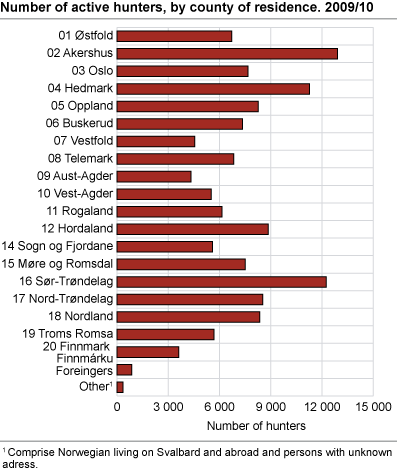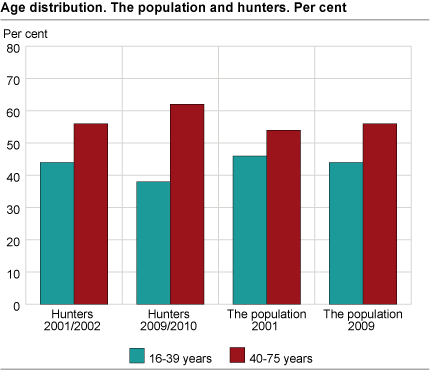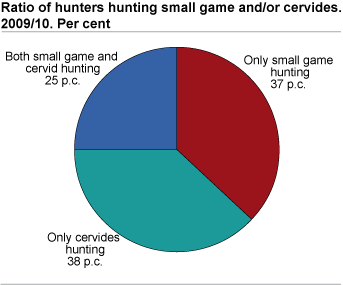Content
Published:
This is an archived release.
The hunters are getting older
During the last nine years, the average age of hunters increased by two years. Although the average hunter is getting older, the average age is lower than in the population.
Hunters who hunted in 2009/2010 were 45 years of age on average, while those who hunted in 2001/2002 were somewhat younger than 43 years. The proportion of hunters younger than 40 has decreased, while those between 40 and 75 years have increased. This change has resulted in a higher average age. The same changes can be observed in the population as a whole, but not as much as among hunters.
Fewer small game hunters than cervid hunters
A total of 143 100 persons hunted in the previous hunting year. Of these, 88 600 hunted small game, and there are now fewer who hunt small game than cervids. One reason for this decrease is that fewer hunt grouse. In recent years, fewer and fewer grouses have been felled , and in the last hunting year the yield was a record low. Moreover, the proportion of hunters with yield and the average yield per hunter has been reduced. Overall, about 52 000 persons hunted grouse in the last hunting year. This is a decrease of 8 per cent from the previous hunting year. A total of 29 300 hunters felled one or more grouses.
More cervid hunters
A total of 90 800 hunters hunted cervids in the autumn of 2009; an increase of 2 300 hunters compared with the previous year. In Norway, hunting of cervids includes moose, roe deer, red deer and wild reindeer. The increase is caused by more hunting of moose, red deer and roe deer. Since the beginning of the 1990s, the felling quota as well as the number of felled red deer has strongly increased. Although it is possible to shoot more red deer than moose , there are still significantly fewer red deer hunters than there are moose hunters. However, the number of red deer hunters is increasing. A total of 40 300 hunters hunted red deer last hunting year, while 60 000 hunted moose. The number of red deer hunters has increased by 7 per cent since last year. Much of the increase has taken place in the new red deer municipalities in Eastern Norway and Trøndelag, where felling quotas have increased in recent years. Therefore, the hunters hunt moose and red deer at the same time in the same areas. In the three large red deer counties of Hordaland, Sogn og Fjordane and Møre og Romsdal, the increase in the number of hunters has not been proportional to the increase in the number of felled animals.
The second most frequent type of cervid hunting, is still roe deer hunting, which engaged 40 500 hunters. Wild reindeer is the cervid species that fewest persons are allowed to hunt , due to individual hunting rights. A total of 8 000 hunters hunted wild reindeer in the autumn of 2009.
Most hunters in rural areas
At country level, 7 per cent of the male population went hunting during the hunting year 2009/2010. The share of hunters is higher in rural areas than in urban areas and cities. In some rural municipalities nearly 50 per cent of the male population older than 16 years hunts. Among the male population in Oslo and Bergen, only 3 per cent went hunting.
More women hunting
The proportion of female hunters is still increasing, and 6.9 per cent of those who paid a hunting fee last hunting year, were women. A total of 7 950 women have hunted, which is equal to 5.6 per cent of those who hunted this hunting season. A total of 5.3 per cent of the small game hunters and 4.8 per cent of the cervid hunters were women.
Tables:
Contact
-
Terje Olav Rundtom
E-mail: terje.olav.rundtom@ssb.no
tel.: (+47) 91 38 60 61
-
Trond Amund Steinset
E-mail: trond.amund.steinset@ssb.no
tel.: (+47) 40 81 13 73




